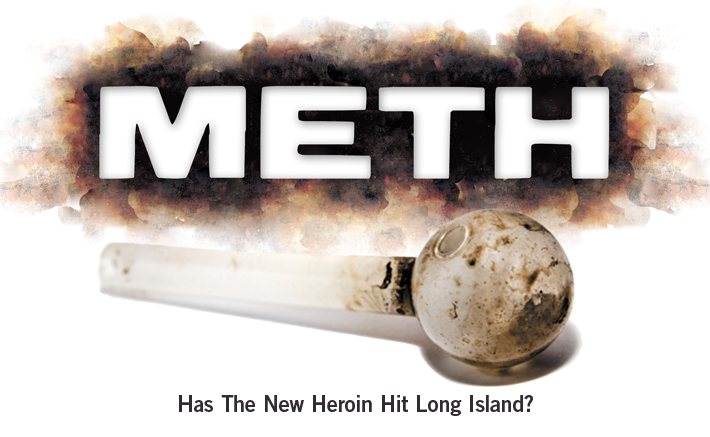

Faces of Meth (www.facesofmeth.us) is a project of the Multnomah County Sheriff’s Office in Oregon that began when a deputy in the Corrections Division Classification Unit, Bret King, put together mug shots of those booked into the Multnomah County Detention Center. Deputy King worked with his co-workers to identify people who had been in custody more than once. He then worked to verify criminal records and files to determine a history of methamphetamine-related use in order to create a realistic presentation about the drug. (Photos: Multnomah County Sheriff’s Office)
HEADLINES HEAD NORTH
Just minutes away from the brick-lined sidewalks of Main Street, a short walk away from the pristine beaches and high-end shopping that keeps East Hampton on the national radar, a one-lane road marked by the kind of white picket street sign familiar to the East End reads Neighborhood House Drive.
In the basement of a typical shake-shingled home on this private gravel road, police discovered the makings of a small meth lab in June 2011, including the volatile and explosive chemical red phosphorus, just yards away from neighboring homes.
It was the last place anyone expected it. But the news didn’t come as a complete shock to LICADD’s Reynolds, who has seen it all play out before.
“We denied heroin was a problem that could impact our kids; we said it could never happen here, this is Long Island after all,” he says. “Well, it found a way to get past the white picket fences.”
Reynolds says he’s seen a significant increase in meth use on LI in the past few months alone. One local school district has recently reached out to him after several students were found under the influence of meth on school grounds, and the drug was found in their possession.
“The areas I’ve heard the most concern are precisely those areas where heroin first emerged—the South Shore, Nassau/Suffolk border,” he says. “That’s what’s frightening is if you look at the pattern we endured through the heroin crisis—you begin to hear the anecdotal reports about young people using heroin, everyone says, ‘No, really?’—it was in very specific communities, and over time it grew and grew and grew, and so here we are today.”
New drug use often sprouts in pockets lingering just below the public radar. And local police confirm that meth is not something they come across regularly as they do in some other states that report thousands, not dozens, of meth lab busts per year. In Montana, where meth has surpassed epidemic proportions, 50 percent of the state’s adult inmates are incarcerated due to meth-related crimes, according to the Montana Attorney General.
“We have almost zero meth arrests,” Nassau County Police spokesman Deputy Inspector Kenneth Lack tells the Press. “We’re nowhere near experiencing the issues they’re experiencing out west.”
The same holds true for local treatment centers, where meth-addicted clients are seen far less than those addicted to heroin and prescription drugs.
“At our Long Island treatment centers, we have not seen an increase in the number of clients listing meth as their primary drug of choice,” says Traci Donnelly, regional director of Phoenix House New York. “This does not necessarily mean that meth isn’t affecting our communities. When a particular drug hits the streets, it may take a year or longer before users seek help and treatment admissions rise.”
And that is exactly what Reynolds worries is happening while LI’s focus is elsewhere.
“We’re only now just beginning to deal with a prescription drug crisis that started 10 years ago, and as we constrict the supply of opiate pain killers and we shut down doctor shopping and pharmacy hopping, and do all those things that we should absolutely be doing, some of those folks will wind up going into treatment when their supply dries up,” he says. “Some of them will turn to other drugs, and those other drugs are likely [to include] methamphetamine.”
His concern isn’t without just cause. Tennessee, one state currently dealing with a large meth problem, reported three treatment admissions for meth addiction statewide in 1996, according to the Center for Behavioral Health Statistics and Quality, Substance Abuse and Mental Health Services Administration. Since then admissions gradually increased each year and by 2004, less than a decade later, they had hit 558, a figure that has remained relatively steady.
After all, meth has one major advantage over other drugs—it can be made in the privacy of the home with relatively easy to come by materials.
A handful of meth labs on LI were discovered in dense, residential areas of Patchogue, Ridge and Farmingville in 2006 as part of a sting the DEA called Operation Red Fusion, named after the primary chemical used in making meth—red phosphorous. Each suspected “cook” was working alone, making meth for personal use. They were only caught because they bought ingredients on the Internet through transactions the DEA intercepted.
Agents arrested seven in all, including a corporate Citigroup executive who had been cooking meth in the living room of his Manhattan penthouse overlooking the United Nations and a doctoral student and Fulbright Scholar at Columbia University cooking meth in his apartment in order to stay awake to write his dissertation.
The faces of meth were changing. Meth was no longer the poor man’s cocaine. Not only had cooking it become a do-it-yourself project that eliminated the middle man of a dealer, but new methods were also making the process simpler than ever. The science had evolved and, like everything these days, dozens of “recipes” became available on the Internet provided by users claiming to be experts, hiding under the Web’s veil of anonymity.




